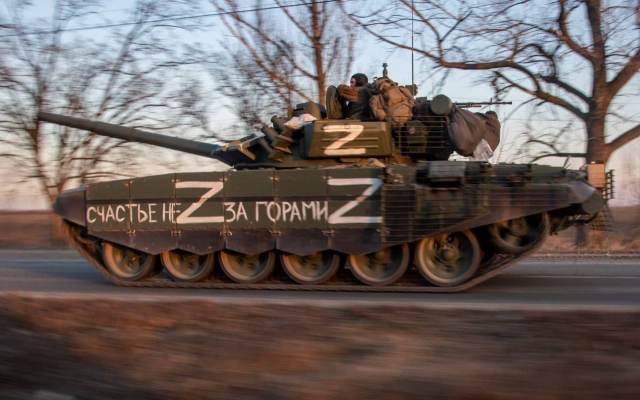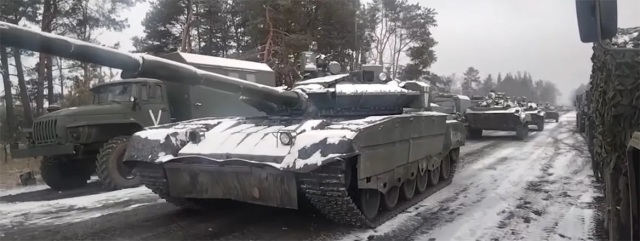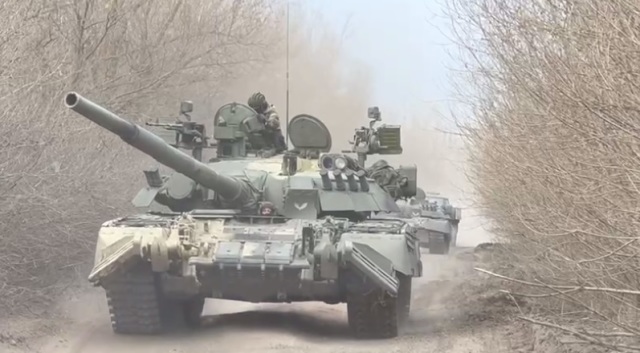On the website of the BritishThe Royal United Services Institute for Defense and Security Studies, formerly the Royal United Services Institution, - RUSI) on April 27, 2022, interesting material was published Sam Cranny-Evans, Sidharth Kaushal "Technical Reflections on Russia's Armored Fighting Vehicles" ("Technical reflections on Russian armored fighting vehicles").

The upgraded T-72B3 tank of the 2016 model (T-72B3M) from the grouping of the Russian Armed Forces on the territory of Ukraine, April 2022 (c) ANNA-NEWS
The war in Ukraine does not reveal anything fundamentally new in tanks. It only confirms the old lessons and reflects the problems of conducting military operations with the use of armored vehicles.
One of the very first images that appeared during the war in Ukraine, in addition to the destruction caused by the strikes of Russian long-range missiles, were pictures of burning Russian armored vehicles. As the conflict progressed, pictures of a number of the most advanced tanks in Russia's arsenal appeared: T-80BVM and T-72B3M. The images of these tanks, from which only burnt hulls remained and dropped due to the detonation of ammunition into the nearest ditch of the tower, may seem shocking. They give the impression that Ukraine has found an antidote in the fight against the tank scourge. Russian Russian tanks, however, if we turn to the design of Russian main tanks - as well as Ukrainian, Polish, Chinese, Indian and many others - these pictures will not be so shocking and not so useful in terms of studying Russian tank troops.
Good
Most Russian tanks have good armor protection in the frontal projection. The frontal armor plate mounted at an angle to the normal in the front of the hull, also called the upper frontal part (VLD), is usually a combination of high-hardness steel and composite materials or materials such as fiberglass, which are known to be a difficult obstacle for weapons such as RPG-7 hand-held anti-tank grenade launchers. The angle of inclination of the armor - 68 degrees - increases its reduced thickness to 547 mm for a number of the earliest versions of the T-72, and for late-release vehicles it may be larger. The armor protection of the tower on Russian tanks is also relatively resistant to the effects of fire damage in the frontal projection. The "cheeks" (side projections) of the cast turret are hollow, which makes it possible to additionally install advanced armor protection, which significantly increases armor resistance to a number of anti-tank weapons.
A dynamic protection system (DZ) is installed outside the tanks. Its quick-detachable elements in the form of DZ containers installed in the side projections of the tower at an acute angle to each other; there is also a DZ VLD module. In essence, the DZ is a metal container, inside of which there are two metal plates, between which an insert with an explosive substance is located at an angle. When a projectile penetrates into the DZ container and collides with an explosive substance located between the metal plates, the latter detonates, pushing the plates apart. This gives a number of effects. Firstly, it increases the amount of material that the projectile must overcome. In this regard, the angle of inclination of the plates is key, since they move away from the initiated explosive - one in the direction of the protected combat vehicle, the other in the direction of the projectile - at an angle, which means that the projectile is likely to be forced to overcome a larger volume of material. Secondly, the projectile experiences compression from the plates, which can destabilize or fragment it; in the latter case, secondary fragments will be better absorbed by the passive armor of the tank.
All this means that Russian tanks are well protected in the frontal projection. In conditions of massive use in conducting combat on opposite courses, for which they are intended, especially in defense, where tanks can be located in trenches, they are powerful and highly effective combat vehicles, provided they are properly operated. But even with improper operation, the Soviet T-72 proved themselves well during the Iran-Iraq War, and their design became an export bestseller.
In addition, the latest models of Russian tanks, such as the T-72B3M, are armed with a 125 mm smoothbore tank gun 2A46M-5. This gun is based on the capabilities of the 2A46, which was armed with the original T-72, and allows you to fire advanced armor-piercing sub-caliber feathered shells with a detachable pallet. These new ammunition - the main means of destruction used in a tank versus tank duel situation - are capable of piercing 500 mm of rolled homogeneous armor at a range of 2 km (see Jane's Land Warfare Platforms: Armored Fighting Vehicles 2020-2021). Improved stabilization and fire control systems also mean that these tanks are apparently more accurate when firing than their Soviet predecessors.
Bad
While the stabilization of the main armament has been improved and the recoil devices have been balanced to reduce the impact on the vehicle during firing, most Russian tanks seem to lack the quality of stabilization of the main armament that is characteristic of most Western tanks. This is best characterized by the video of the German Leopard 2, which walks along the tankodrome with a glass of beer mounted on the muzzle of its cannon. Such stabilization allows most Western tanks to conduct high-precision fire on the move, moving at high speed off-road over rough terrain. This increases the survivability of the tank, since it does not need to stop to open fire, and provides the crew with tactical advantages. Russian tank designs are less adapted to firing on the move, and there is not much evidence that they are as powerful as Western models.
The second component of the problem is the technical appearance of the fire control system of Russian tanks. Sighting devices and ballistic calculators, as a rule, are less modern than their Western counterparts. Some progress was made in connection with the import (until 2014) of thermal imagers from Thales and subsequent efforts to produce these systems domestically, which gave most of the upgraded Russian tanks the opportunity to fight at night, in conditions of limited visibility and smoke. Less information is available about the ballistic computer of the fire control system, which is responsible for giving the gun the necessary elevation angle and responding to the firing data entered by the crew to ensure an accurate shot.
Tanks of Russian designs also have a very cramped interior space. Few Western tankers would want to drive a main tank with a crew of three, which is standard for all Soviet vehicles, starting with the T-64. Performing the simplest tasks for tank crews, such as replacing and repairing tracks, refueling and monitoring the situation, seems to be more difficult for three people than four. However, the cramped interior space and the crew reduced to three people can be compensated by the well-practiced actions of the crew members. And already due to the long duration of time during which these tanks are in service, it is likely that Russian tankers will rather take into account these technical limitations when designing combat vehicles and developing tactics for their use, rather than trying to reproduce the combat capabilities of Western tanks.
Evil
An automatic ammunition control system located under the tank turret was introduced into the design of Soviet-era tanks, starting with the T-64 and further in the T-72, T-80 and T-90 families of vehicles, albeit with some minor differences. It holds 22 shots of separate (charge and projectile) loading. The system is called an automatic loader (AZ) with a rotating conveyor and serves to feed shots from the hull [so in the original text - bmpd] of a tank into the breech of a tank gun: first a projectile is loaded, then a charge, after which another shot is fired in accordance with the request of the gunner, which allows the latter to fire.
The use of a rotating AZ conveyor allowed Soviet designers to reduce the height of tanks, as well as the number of crew, reducing it from four people used in most other projects to three. The reasons for this are objectively justified: the smaller internal volume of the tank reduces the booking area, which, in turn, reduces the mass. A lower altitude gives a smaller area of damage to enemy tanks by fire, and automatic loading allows the tank to fire when moving over rough terrain at almost any speed, although accuracy suffers at the same time. At the same time, a number of other constructive decisions were made. Most of the armor of Soviet-era tanks is located in the front of the vehicle and serves to protect the turret and the frontal part of the hull. Most tank designs lack armor protection in the side projections of the hull and turret - and this is more characteristic of Soviet models of armored vehicles than their Western counterparts.
This is a problem for Soviet tanks, since the rotating AZ conveyor is located in the hull, which is very well protected from the VLD, but to a lesser extent - in the side projections. If an enemy shell that hits the tank breaks through the side or roof of the hull, it can get into the laying of ammunition, which will lead to spontaneous ignition of charges. It is at this moment that the propellant charges and explosive shells ignite - a fire occurs, which quickly spreads due to the lack of fire barriers between shots in the stacks. If there is a fire of a sufficient number of shots and their detonation, this often leads to an explosion, as a result of which the tank tower is thrown a considerable distance, and the entire crew is killed.
The Russians and Ukrainians tried to solve these problems by installing a set of DZ. The latter is especially effective against anti-tank weapons that go down in history, such as the RPG-7 and its analogues, which use cumulative combat units to defeat targets. However, the DZ also has its limitations, and they are especially noticeable in relation to the side projections of armored combat vehicles: it is difficult to install the DZ containers in the side projections of the tank body so that the containers are positioned at an angle. Therefore, on Russian machines, the DZ containers are installed in the same plane with the sides of the hull. They can reduce the damaging effect of the projectile, especially if the latter collides with them at a known angle, but to a lesser extent than when installed at an angle of the DZ containers themselves.
The DZ is complemented by passive armor protection behind it, such as rolled homogeneous armor, which in any case affects the projectile; however, it is hardly possible to install additional passive armor protection in the side projections of the tank hull - sufficient to stop an anti-tank grenade from Panzerfaust 3 with a penetration of about 800 mm rolled homogeneous armor protected by DZ. Nevertheless, a number of testimonies from Grozny indicate that T-72 tanks are able to withstand numerous hits from rocket-propelled grenades of hand-held anti-tank grenade launchers and guided missiles of anti-tank missile systems without a catastrophic explosion. Separate reports from Ukraine confirm this conclusion.
Thus, the catastrophic losses of Russian and Ukrainian tanks are the result of a number of problems: the location of ammunition shots to tank guns, which makes it difficult to armor protection in the side projections; the absence of an armored partition separating the crew from the ammunition; the ease with which most tanks are hit in the side projections. The most important thing is that all these problems were known before. Russian tankers have experienced them for themselves in Chechnya and Georgia. The troops of Western states could observe the same consequences when conducting military operations against Iraqi troops in 1991 and 2003. In fact, almost every armed conflict in which Soviet-era tanks participated, from the T-64 onwards, showed the vulnerability of these structures to being hit by anti-tank weapons in the upper and side projections. However, it is important to note here that images of the final state of destroyed tanks may contradict the nature of the previous battle - it is often fierce and fleeting.
What does all this mean?
The first thing to note is the fact that every single tank design is a series of compromise solutions. The development team is responsible for balancing mobility, firepower and armor protection in accordance with the needs of the customer. Because of this, Russian tanks and their Soviet predecessors do not have shortcomings by definition: the installation of AZ was a conscious decision made to improve mobility and provide sufficient armor protection to perform the tasks intended. They have certain disadvantages in relation to the features of modern warfare, but this can be attributed to any design, be it mass, cost, firepower or insufficient armor protection. In short, there is no perfect tank.
The second is that this article does not cover other Russian armored fighting vehicles, such as the BMP-3 infantry fighting vehicle and the BTR-82 armored personnel carrier. These vehicles, as a rule, have improved armor protection in the frontal projection and rarely have improved composite armor of their Western counterparts, which would allow them to withstand fire from large-caliber machine guns and cannons in the side projections. They also often lack mine protection, which puts them at a disadvantage when the enemy uses engineering mines and improvised explosive devices. However, the same reservations apply to them as in the case of the main tanks: they are designed to be used in a certain way, which emphasizes their strengths - firepower and mobility.
The third and last is the need to consider Russian tactics, forms and methods of warfare, which, as a rule, rely on combined arms combat in the expectation of using the combat capabilities of artillery, front-line and army aviation in order to deliver a crushing blow to the enemy. The principle of decentralization (eng. mission command, it. Auftragstaktik) in the management of troops (forces) - delegation of authority and initiative to the grassroots levels of management - is rarely practiced during the combat training of the Russian army. This means that the military formations of tank troops, when acting independently, that is, without being supported by other types of troops (forces), apparently perform those tasks that they are not trained in. The importance of this factor cannot be overestimated; its lack of accounting previously led analysts to mistakenly underestimate Russian-made armored vehicles. For example, the unsuccessful actions of Russian-made Iraqi T-72 tanks during Operation Desert Storm made many analysts doubt their functionality compared to the main tanks of Western countries. However, subsequent simulation of the Battle of 73 Easting [February 26, 1991] using the JANUS system of the Ernest Lawrence Livermore Laboratory showed that when the actions of the crews of Iraqi tanks were modeled as using effective tactics of combined arms combat, including reconnaissance support and infantry support, they destroyed 50 units of military equipment of the American 2nd Armored Cavalry Regiment (2nd Armored Cavalry Regiment) - more than 70% of its combat strength in the specified battle - despite the fact that, in general, the Iraqis were defeated. And this is despite the fact that the simulation provided for the advantages of American M1 Abrams main tanks in areas such as firing range and the use of thermal imaging sights, and also took into account the dominance of American aviation in the air.
In general, Russian armored vehicles have relatively high capabilities; they have yet to overcome the design legacy of the past, exposing tank crews to risks. However, images of destroyed tanks rarely give an idea of how these vehicles affected the course and outcome of the battle before they were destroyed. Therefore, it is important to consider Russian armored vehicles in context and understand that they are apparently more effective at a military-technical level, different from military operations in Ukraine.

Upgraded T-80BVM tank of the Russian Armed Forces. Kiev region, 07.03.2022 (c) a frame from the video of the TV channel "Zvezda"

T-80U tanks from the 4th Guards Tank Kantemirovsky Division in the Kharkiv region during the transfer to the Izyum direction, April 2022 (with) a frame from the video of Alexander Kotz @sashakots
